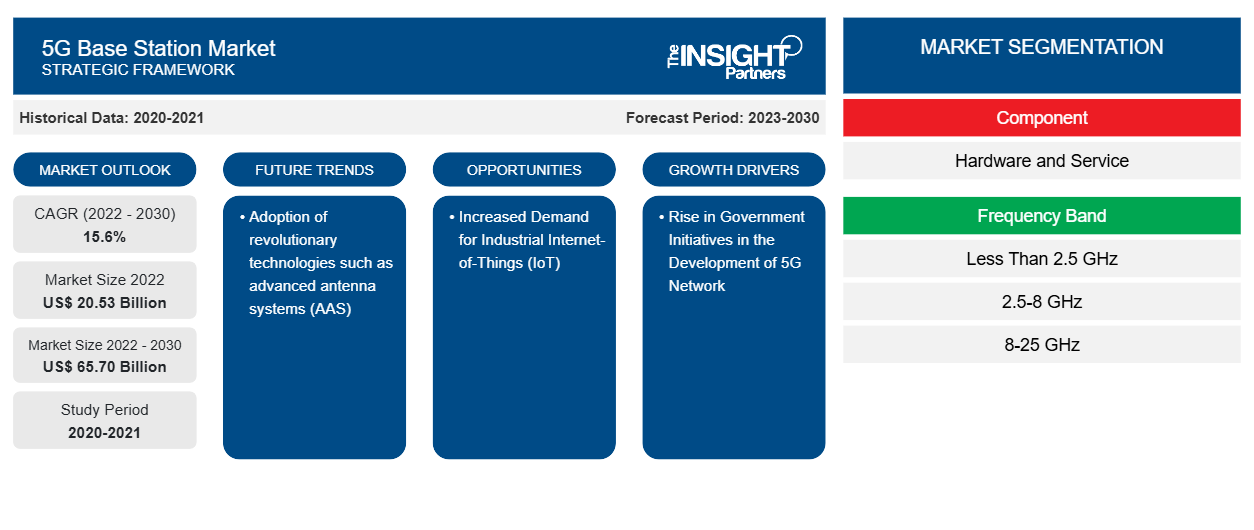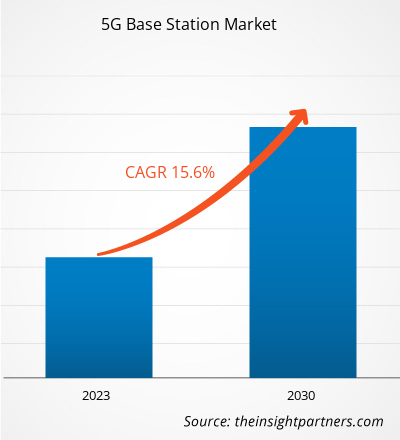The 5G Base Station market size is projected to reach US$ 65.70 billion by 2030 from US$ 20.53 billion in 2022. The market is expected to register a CAGR of 15.6% during 2022–2030. The adoption of revolutionary technologies such as advanced antenna systems (AAS) is likely to remain a key trend in the market.
5G Base Station Market Analysis
The increased demand for industrial internet-of-things (IIoT) and edge computing, are important driving forces behind 5G Base Station adoption.
5G Base Station Market Overview
The 5G base station is the key equipment of the 5G network, which provides wireless coverage and realizes wireless signal transmission between the wired communication network and the wireless terminal. The architecture and shape of base stations directly affect the way 5G networks are deployed. With a rise in frequency, the attenuation during signal propagation increases, leading to a higher base station density of the 5G network. In May 2022, China built 1.6 million 5G base stations and became the first country in the world to build a large-scale 5G network based on the independent networking model. In 2022, China added 887,000 new 5G base stations. The number of 5G base stations reached ~2 million, accounting for more than 60% of the world's total.
Customize This Report To Suit Your Requirement
You will get customization on any report - free of charge - including parts of this report, or country-level analysis, Excel Data pack, as well as avail great offers and discounts for start-ups & universities
5G Base Station Market: Strategic Insights

-
Get Top Key Market Trends of this report.This FREE sample will include data analysis, ranging from market trends to estimates and forecasts.
5G Base Station Market Drivers and Opportunities
Increased Demand for Industrial Internet-of-Things (IoT) to Favor Market
With an increased demand for industrial internet-of-things (IIoT) and edge computing, there is a rising demand for private 5G networks and small cell base stations. A private 5G network is a dedicated Local Area Network (LAN) that provides enterprise, industrial, and other customers with increased internet access. Next-generation network services are projected to satisfy the requirement for crucial wireless communication for public safety, industrial operations, and critical infrastructure connectivity as they evolve. Additionally, the global market is growing due to the increasing need for ultra-reliable, low-latency connections for applications based on the Industrial Internet of Things (IIoT), including robots, collaborative industrial cameras, industrial cameras, and industrial sensors.
Rise in Government Initiatives in the Development of 5G Network
Telecommunication is one of the fastest-growing industries across the globe. The US government and various industries are rapidly adopting 5G technology to achieve its full potential in the country as well as promote digital business transformation. For instance, in September 2023, the US National Science Foundation Directorate for Technology, Innovation and Partnerships (TIP) is challenges associated with 5G communication infrastructure and operations through a US$ 25 million investment to advance five convergent teams. Also, in April 2023, the US Secretary of Commerce announced the launch of the Public Wireless Supply Chain Innovation Fund, which will invest US$ 1.5 billion in the development of interoperable and open networks. With this funding, the future of 5G and next-gen wireless technology can be built by the US and its global allies and partners. Furthermore, governments of various countries across APAC are taking several initiatives and investing in 5G technology.
5G Base Station Market Report Segmentation Analysis
Key segments that contributed to the derivation of the 5G Base Station market analysis are component, frequency band platform, cell type and end user.
- Based on component, the 5G base station market is bifurcated into hardware and service. The hardware segment held a significant market share in 2022.
- Based on frequency band, the 5G base station market is categorized into less than 2.5 GHz, 2.5–8 GHz, 8–25 GHz, and more than 25 GHz. The 2.5–8 GHz segment held the largest share of the market in 2022.
- Based on cell type, the 5G base station market is bifurcated into macrocells and small cells. The small cell segment is further segmented into microcell, picocell, and femtocell.
- Based on end user, the 5G base station market is categorized into industrial, commercial, and residential. The commercial segment held the largest share of the market in 2022.
5G Base Station Market Share Analysis by Geography
The geographic scope of the 5G Base Station market report is mainly divided into five regions: North America, Asia Pacific, Europe, Middle East & Africa, and South & Central America.
North America dominated the market in 2022. North American consumers are increasingly adopting 5G-enabled devices, such as smartphones, tablets, and IoT gadgets. As a result, there is a growing need for 5G infrastructure to support these devices with high-speed data and low latency. Telecom operators in North America are engaged in fierce competition to provide the best 5G services. This competition drives the deployment of more 5G base stations to offer better coverage and faster speeds. For instance, in August 2023, Eastlink partnered with Nokia to enhance its 5G network across Canada. Under this partnership, Eastlink is modernizing its mobile network by using Nokia's AirScale portfolio, including 5G Radio Access Network (RAN) technology, to deliver fast speeds, unparalleled performance, and expanded network capacity.
5G Base Station Market Regional Insights
The regional trends and factors influencing the 5G Base Station Market throughout the forecast period have been thoroughly explained by the analysts at The Insight Partners. This section also discusses 5G Base Station Market segments and geography across North America, Europe, Asia Pacific, Middle East and Africa, and South and Central America.
5G Base Station Market Report Scope
| Report Attribute | Details |
|---|---|
| Market size in 2022 | US$ 20.53 Billion |
| Market Size by 2030 | US$ 65.70 Billion |
| Global CAGR (2022 - 2030) | 15.6% |
| Historical Data | 2020-2021 |
| Forecast period | 2023-2030 |
| Segments Covered |
By Component
|
| Regions and Countries Covered |
North America
|
| Market leaders and key company profiles |
|
5G Base Station Market Players Density: Understanding Its Impact on Business Dynamics
The 5G Base Station Market is growing rapidly, driven by increasing end-user demand due to factors such as evolving consumer preferences, technological advancements, and greater awareness of the product's benefits. As demand rises, businesses are expanding their offerings, innovating to meet consumer needs, and capitalizing on emerging trends, which further fuels market growth.

- Get the 5G Base Station Market top key players overview
5G Base Station Market News and Recent Developments
The 5G Base Station market is evaluated by gathering qualitative and quantitative data post primary and secondary research, which includes important corporate publications, association data, and databases. A few of the developments in the 5G Base Station market are listed below:
- Alpha Networks Inc. announced that it is attending the Barcelona Mobile World Congress (MWC 2024) and will showcase its next-generation O-RAN Radio Unit (O-RU) solution for 5G base stations at the MWC Taiwan Pavilion organized by the Industrial Development Bureau, MOEA. (Source: Alpha Networks Inc, Press Release, February 2024)
- BLiNQ Networks partnered with EdgeQ to launch the PCW-400i, an advanced 5G small cell base station based on the latter’s system-on-chip (SoC). Per EdgeQ, the new product belongs to a new class of 5G NR Wireless network edge products. It has a compact form factor that can adapt to varied applications from public venues, warehousing, industrial spaces, retail spaces, academic institutions, and office deployments. (Source: BLiNQ Networks, Press Release, October 2023)
5G Base Station Market Report Coverage and Deliverables
The “5G Base Station Market Size and Forecast (2020–2030)” report provides a detailed analysis of the market covering below areas:
- 5G Base Station market size and forecast at global, regional, and country levels for all the key market segments covered under the scope
- 5G Base Station market trends as well as market dynamics such as drivers, restraints, and key opportunities
- Detailed PEST/Porter’s Five Forces and SWOT analysis
- 5G Base Station market analysis covering key market trends, global and regional framework, major players, regulations, and recent market developments
- Industry landscape and competition analysis covering market concentration, heat map analysis, prominent players, and recent developments for the superconductor market
- Detailed company profiles
Frequently Asked Questions
What is the expected CAGR of the 5G Base Station market?
What would be the estimated value of the 5G Base Station market by 2030?
Which region dominated the 5G Base Station market in 2022?
What are the driving factors impacting the 5G Base Station market?
Which are the leading players operating in the 5G Base Station market?
What are the future trends of the 5G Base Station market?
- Historical Analysis (2 Years), Base Year, Forecast (7 Years) with CAGR
- PEST and SWOT Analysis
- Market Size Value / Volume - Global, Regional, Country
- Industry and Competitive Landscape
- Excel Dataset
Recent Reports
Related Reports
Testimonials
Reason to Buy
- Informed Decision-Making
- Understanding Market Dynamics
- Competitive Analysis
- Identifying Emerging Markets
- Customer Insights
- Market Forecasts
- Risk Mitigation
- Boosting Operational Efficiency
- Strategic Planning
- Investment Justification
- Tracking Industry Innovations
- Aligning with Regulatory Trends





















 Get Free Sample For
Get Free Sample For